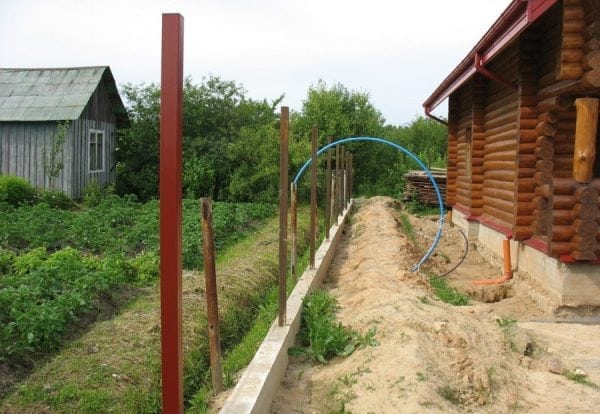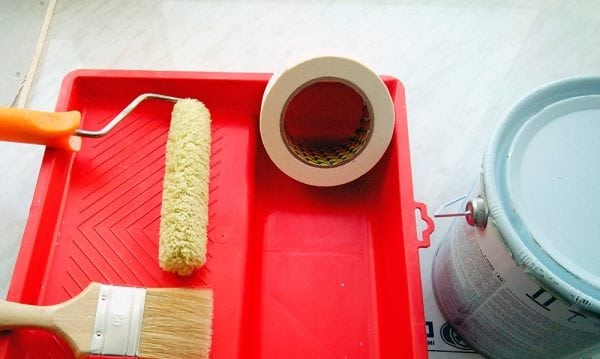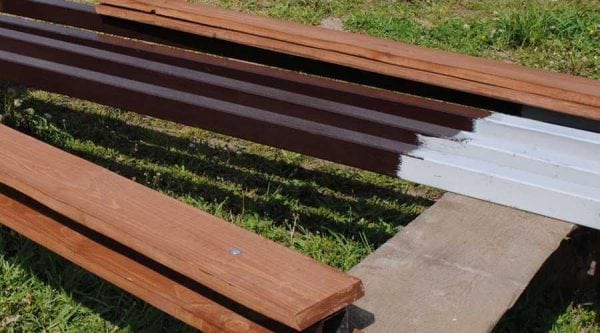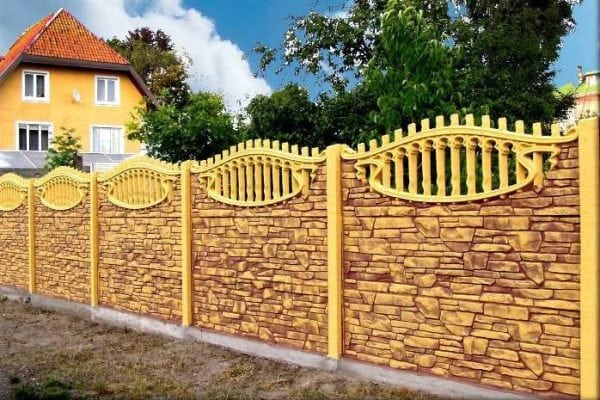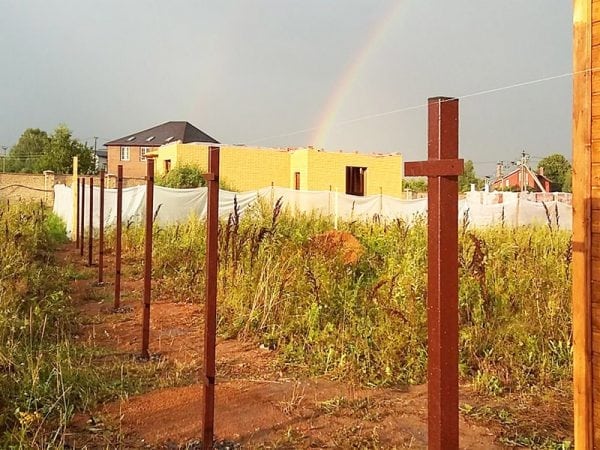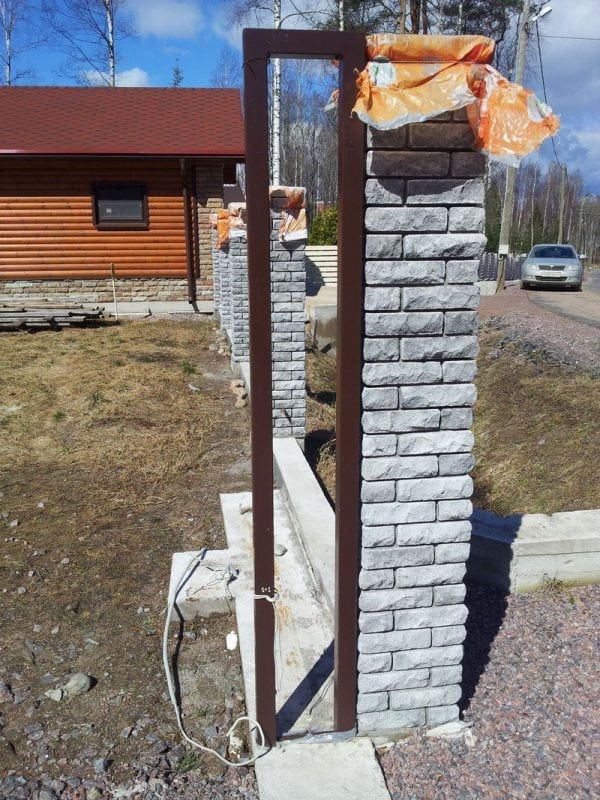If it is necessary to paint the post, it is necessary to take into account the material of construction, the type of paint and the type of tool, as well as a host of other circumstances.
- Tool selection
- Wooden posts
- Reinforced Concrete Pillars
- Metal posts
- Brick pillars
- Cement posts
- Conclusion
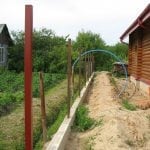
Tool selection
The most popular tool for painting fences and poles is the standard paint brush. First of all, such a choice is dictated by the need to paint in inaccessible places and on relief sections of the structure. For coloring most types of materials, the best choice is a natural hair brush. Before starting work, the brush should be fluffed - this is necessary in order to get rid of loosely fixed bristles, since otherwise they will remain on the painted surface during painting.
For a flat surface, a roller with a medium or long pile is suitable. Foam rollers are not the best choice, because after them small air bubbles remain on the surface.
Another option is a spray gun. In order to treat hard-to-reach areas, it is necessary to change the spray angle and ink supply power. Modern models of spray guns allow you to work not only quickly, but also economically, in terms of the consumption of paintwork.
Note! Priming and painting is recommended with different tools. If this is not possible, the instrument must be thoroughly washed and dried between different operations.
If the pillar is covered with a layer of old paint, the surface must be cleaned before starting painting. To mechanically clean the column, you will need a metal brush, a scraper and a spatula. A more advanced method of cleaning is a special nozzle on an electric drill. You can also use sandpaper, a rag or chemicals. The thermal cleaning method involves a building hair dryer, gas burner or soldering iron.
to contents ↑Wooden posts
Wood is often used to make pillars. Although this is quite democratic, it is not the most reliable material due to the following factors:
- The tree is afraid of moisture and prone to decay, therefore, the paint should contain an antiseptic. Acrylic compounds are well suited for wood. They are water based and can be used for wooden fence painting and surfaces located on the street. To protect the part of the structure located underground, it is possible to recommend the Black Resin or Black Sleepers paints. These compounds are produced on a bitumen basis. In addition, "Black sleepers" is particularly resistant to acid-base environment. Often, to protect the wood from moisture, the material is processed by firing. After firing, the column is impregnated for 7 days in a solution of diesel fuel and mining.
- Wood is destroyed under the influence of ultraviolet radiation. The cause of the destruction is the loss of lignin due to exposure to radiation.To reduce the effects of ultraviolet radiation, paints based on organic solvents are used. Paints from such brands as Tikkurila, Pinotex and several others have earned a good reputation in woodwork.
- Bugs cause considerable damage to wood, which contribute to the penetration of water into the structure of the material. To combat bugs use aqueous antiseptic drugs. These include, for example, Pinotex Base. The drug "Decotek" is made on the basis of alkyds and also protects well from ultraviolet radiation and humidity.
- Wood refers to flammable materials. To protect the material from flame, flame retardants are used, for example, Biofiren or Senezh OgneBio.
Work specifics:
- Plain wood paint is not the best option. It is preferable to choose a facade paint for wooden surfaces, for example, based on acrylates. It not only does not smell and dries quickly, but also contains special additives that protect the material from fungus and mold.
- Coating compositions can be used, thanks to which a sealed film appears on the surface, which interferes with the evaporation of the liquid. Coating coatings are oil or alkyd based and include organic solvents. The advantage of such paints at a low cost, however, and the service life of the coatings formed by them leaves much to be desired.
- Acrylic paints and varnishes allow you to create durable coatings that reliably serve for about a dozen years. If necessary, emphasize the natural texture of the column, you can use transparent impregnation and varnishes.
- Wooden parts need to be painted before they are installed. It is recommended that the end parts and fresh ones are especially carefully painted over, since moisture penetrates through them faster.
- Old paint is removed from wood in the same way as from metal: by thermal, mechanical or chemical methods.
- Removing old paint is necessary only if the painting will be carried out by a completely different type of coloring matter (for example, acrylic on oil).
Reinforced Concrete Pillars
Concrete combined with metal allows you to create reliable structures. However, such material does not look very attractive. Painting the concrete surface turns a dull-looking pillar into a beautiful detail of the exterior. In addition, a painted concrete product, the product will serve more, since the paint will protect it from destruction under the influence of external factors.
Painting should be carried out using facade water-dispersion compositions based on acrylic, latex, silicone. Such paint penetrates deep into the material, protecting it from moisture. Examples of suitable coatings include Tikkurila (Finland) or Caparol (Germany). Paint consumption rates are highly dependent on the type of concrete and the quality of the coating. However, on average, we can say that the average consumption is 300 milliliters per square meter.
It is possible to paint a concrete surface not earlier than after after its manufacture. Throughout this period, the material dries and gains working qualities. Before painting, all defects are removed with a metal brush. Explicit defects are smeared with plaster. If the material has non-removable bristles, they should be removed with ammonia or acetic acid.
Before painting, concrete is recommended to be primed. This, incidentally, will seriously reduce the consumption of expensive facade paint. If separate shoes are not provided for the pillars, the underground part of the structure must be treated with bitumen-containing material.
to contents ↑Note! Painting is best done on a warm, but not too hot day. But in rainy weather, painting is not recommended.
Metal posts
Preparatory and painting work is as follows:
- Cleaning from traces of corrosion (sandpaper, wire brush, power tool, rust converter). Chemical cleaning methods can be used, but toxicity of chemicals should be considered. Rust is well cleaned by heating, which is facilitated by the difference in expansion coefficients.
- Degreasing the surface with a solvent.
- Primer metal. If the product is hollow, it is advisable to apply soil to the internal surfaces. Do not save on choosing a primer, since films formed by cheap materials are short-lived. For oil paints, the use of glyphthalic primers is recommended. For acrylic compositions and auto enamels, phenol-formaldehyde primers are best suited. There are also specialized primers that convert rust into a corrosion-resistant coating.
- Processing the underground part of a metal column with a bitumen-containing substance (mastic).
- Application of paint.
Brick pillars
Brick pillars and fences are painted quite rarely. However, if such a need arose, it is necessary to perform the following set of work:
- Brick painting It is possible not earlier than a year after the construction. Like concrete, a brick has many pores, it must completely dry and acquire all its inherent characteristics.
- Preparatory work is carried out in the same way as in the case of concrete surfaces (applying plaster to defects, removing efflorescences, priming).
- Mold often appears on the brick. You can remove it with bleach. Then the surface is brushed.
- To give the brick water-repellent characteristics and vapor impermeability, it is recommended to impregnate the material with a hydrophobic substance (for example, “Wepost Luxe” or “Tiprom U”).
- The material must dry well before applying paint. Specific dates are indicated by manufacturers on the packaging.
Types of suitable facade paints for brick:
- Vinyl paints and varnishes. Differs in cheapness, but rather high-quality paint. Side effect - gives a shrink.
- Acrylate based latex paint. The average option for the price / quality ratio.
- Silicone coatings. The best choice, in terms of quality, but you will have to pay extra money for this.
- Silicate compositions (based on liquid glass). An example is the paint of the German manufacturer Osmo. These are two-component coatings with excellent physical and mechanical characteristics.
Cement posts
Pillars made of asbestos cement are the most low-cost type of enclosing structures. They do not look very attractive and are characterized by low physical and mechanical qualities. Moreover, this material is resistant to moisture. It is not necessary to paint such columns, since without them they can be used for several decades. However, staining will give asbestos-cement pillars their lack of decorativeness.
Advice! Concrete pouring significantly increases the strength properties of asbestos-cement structures.
Below are a few paints specially designed for coloring asbestos cement products:
- Slate paint Shikril. The dry and clean material is processed by color composition. The paint is pre-diluted with an organic solvent in the proportion indicated on the package. Painting is carried out only in a respirator, as the composition is toxic. This paintwork refers to moisture-resistant, frost-resistant, flexible and durable paintwork.
- Trademark "Kilpi" from the Finnish company "Tikkurila". It has the entire list of positive characteristics, but its main feature is resistance to low temperatures.LKM consumption - approximately 500 grams per square meter.
- Trademark "Dachbeschichtung" from the German company "Dufa". The main characteristic is the best adhesion among competitors (the ability to adhere to the material to be painted). Paint consumption does not exceed 150 grams per square meter.
- Acrylakma paint from the Lakma company. LKM consumption is approximately 170 grams per square meter. The coating dries after 45-60 minutes.
- Trademark "Polyfan" manufactured by the company "Polifan-L". Material consumption - up to 350 grams per square meter.
to contents ↑
Conclusion
Pillars and fences, as well as the front part of the building, are the face of a private house. Not only the attractiveness of the structure and the durability of structures, but also the opinions of others and neighbors about the owner of this house, largely depend on the quality of the chosen paint and the thoroughness of the work done.

